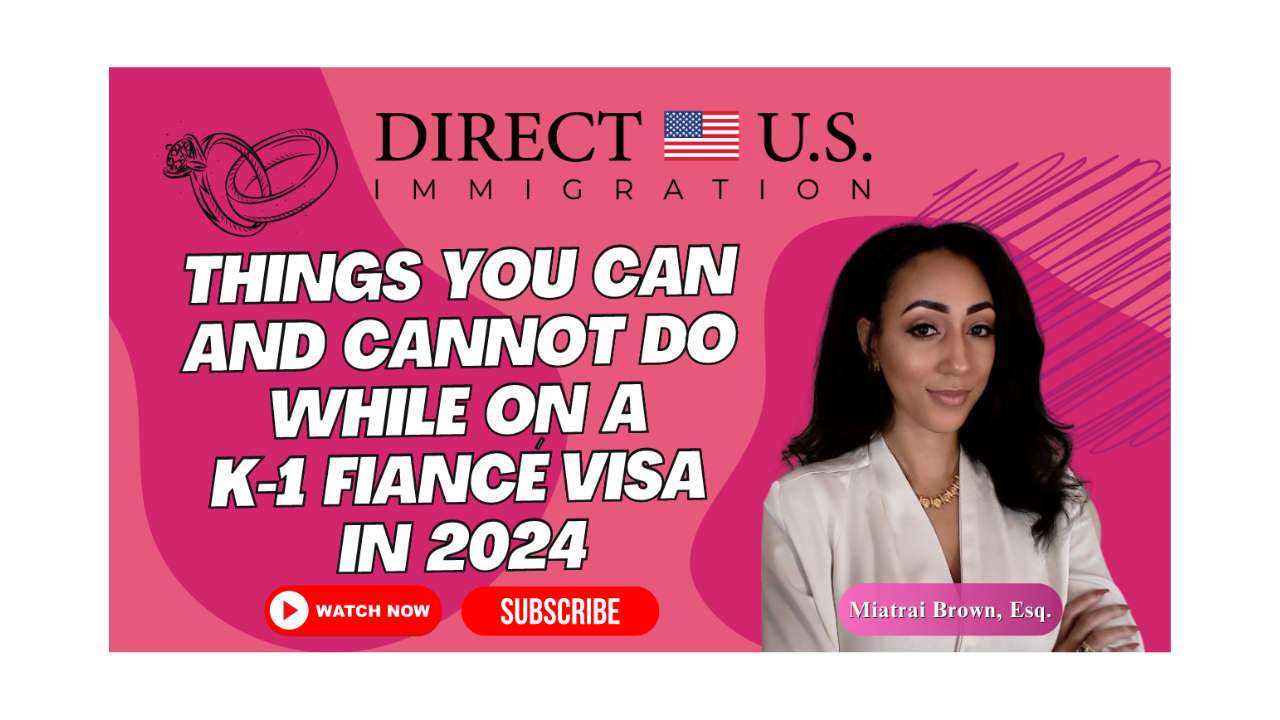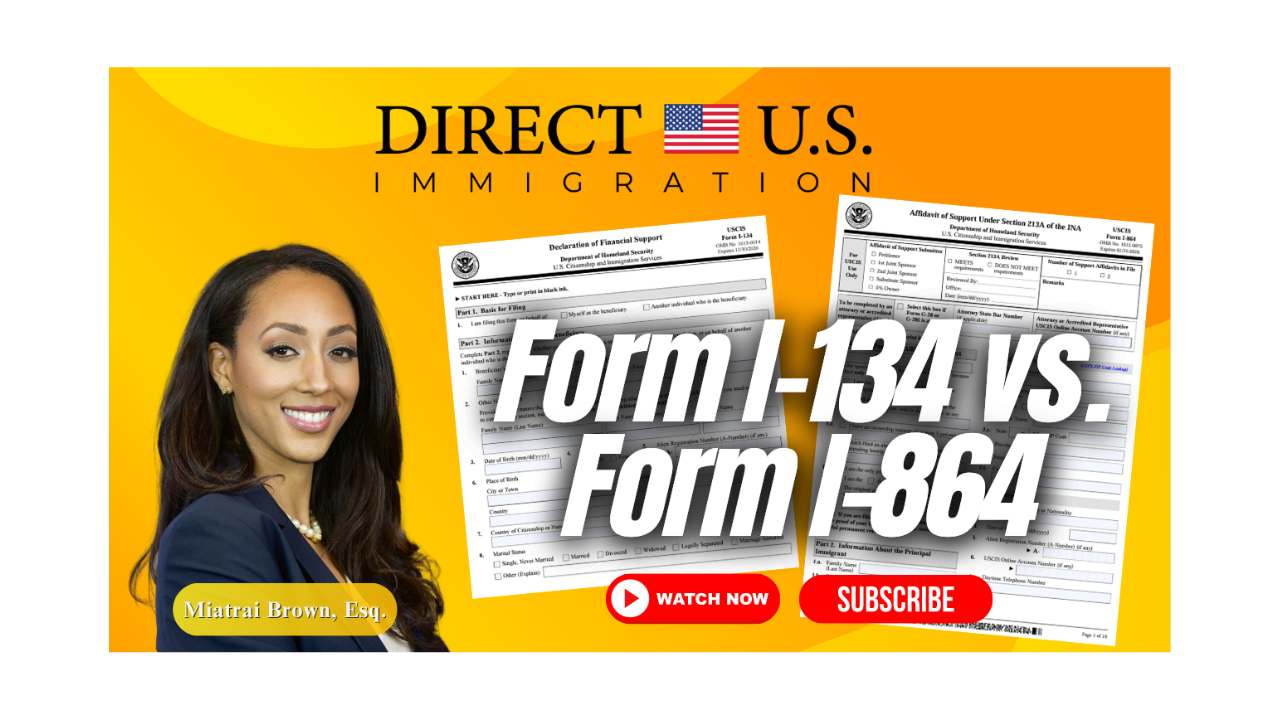As you know, Form I-134 and Form I-864 are two essential documents in the U.S. immigration process. Whether you’re planning a temporary visit to the United States or seeking permanent residency, understanding the differences between these forms is crucial. In this video, we’ll explore the purpose, application, and key distinctions of Form I-134 and Form I-864 to help you navigate the complex world of U.S. immigration.
Form I-134: Affidavit of Support
Form I-134 is an Affidavit of Support designed for nonimmigrant visa applications, such as fiancé(e) visas (K-1/K-2 visas) or humanitarian paroles. It serves as a declaration by a U.S. citizen or permanent resident who is sponsoring a foreign national visiting the U.S. temporarily. The purpose of Form I-134 is to demonstrate to the U.S. immigration authorities that the sponsor has the financial means to support the visitor during their stay in the country.
Key Points about Form I-134:
1. Nonimmigrant Visas:Form I-134 is primarily associated with nonimmigrant visa applications, facilitating temporary stays in the United States.
2. Financial Support:By filing Form I-134, the sponsor agrees to provide financial support to the visitor during their temporary stay, covering expenses such as accommodation, food, transportation, and medical care.
3. Documentation:Along with Form I-134, sponsors may need to provide supporting documents to verify their financial stability, such as bank statements, employment verification letters, or tax returns.
4. Duration of Support:The sponsor’s obligation under Form I-134 is limited to the duration of the visitor’s authorized stay in the United States.
Form I-864: Affidavit of Support Under Section 213A of the INA
Form I-864, on the other hand, is an Affidavit of Support used for immigrant visa applications, particularly for individuals seeking permanent residency (green cards) through family-based sponsorship. It is a legally binding contract between the sponsor and the U.S. government, ensuring that the sponsored immigrant will not become a public charge and that the sponsor has the financial means to support them.
Key Points about Form I-864:
1. Immigrant Visas:Form I-864 is associated with immigrant visa applications, including family-based green card applications.
2. Financial Responsibility:By signing Form I-864, the sponsor agrees to provide financial support to the immigrant beneficiary until certain conditions are met, at an amount not less than 125% of the Federal Poverty Guidelines (100% for military).
3. Legally Binding:Form I-864 creates a legally enforceable contract between the sponsor and the U.S. government, with the government having the right to seek reimbursement from the sponsor if the sponsored immigrant receives certain means-tested public benefits.
4. Income Requirements:Sponsors must meet certain income requirements to qualify to sponsor an immigrant using Form I-864. If the sponsor’s income is insufficient, they may need to obtain a joint sponsor who meets the income requirements.
5. Duration of Support:The sponsor’s obligation under Form I-864 continues until specified conditions are met, even if the sponsored immigrant divorces the sponsor or the sponsor’s financial situation changes.
The timing for filing Form I-134 and Form I-864 depends on the type of visa application and the stage of the immigration process.
Form I-134: Affidavit of Support
Form I-134 is typically filed by the sponsor when supporting a nonimmigrant visa application, such as a fiancé(e) visa (K-1/K-2), or humanitarian parole. It is submitted as part of the visa application process, usually at the embassy or consulate where the visa interview takes place. Sponsors may also need to provide supporting documentation along with Form I-134 to demonstrate their financial capability to support the visa applicant during their temporary stay in the United States.
Form I-864: Affidavit of Support Under Section 213A of the INA
Form I-864 is filed in the context of immigrant visa applications, particularly for individuals seeking permanent residency (green cards) through family-based sponsorship. It is submitted after the initial immigrant petition (such as Form I-130 for family-based sponsorship) has been approved by USCIS, or concurrently with Form I-485 to USCIS. If the case is consular processed, Form I-864 is typically submitted to the National Visa Center (NVC) as part of the immigrant visa application process. The sponsor must provide evidence of financial ability to support the immigrant beneficiary at an amount not less than 125% of the Federal Poverty Guidelines.
Overall, understanding the differences between Form I-134 and Form I-864 is essential for sponsors and applicants navigating the U.S. immigration process. Whether you’re planning a temporary visit or seeking permanent residency, these forms play a critical role in demonstrating financial support and ensuring compliance with U.S. immigration laws.
Bonus Information
As promised, here’s some bonus information that you may not know about:
Embarking on the journey of filing Form I-134 or Form I-864 for your U.S. immigration application can be daunting. However, enlisting the help of an immigration lawyer can significantly ease the process. Here are three key tips why hiring an immigration lawyer can make all the difference in successfully navigating the complexities of these forms.
Tips:
1. Expert Guidance: An immigration lawyer provides expert guidance on the intricate requirements of Form I-134 and Form I-864, ensuring all documentation is correctly prepared and submitted to minimize errors that could jeopardize your application.
2. Personalized Strategy: With a lawyer, you’ll receive a customized strategy tailored to your specific situation, maximizing your chances of success whether you’re applying for a temporary visa or seeking permanent residency.
3. Advocacy and Representation: Your lawyer acts as your dedicated advocate, representing your interests throughout the process from form preparation to visa interviews, ensuring your rights are protected and navigating any potential challenges with confidence.
Thanks for tuning in today. Be sure to check the caption below this video. We’ve got questionnaires for different types of visas so that we can help you determine which visa is most appropriate for you. And if you’re traveling soon, we also have a list of some of my travel favorites.



